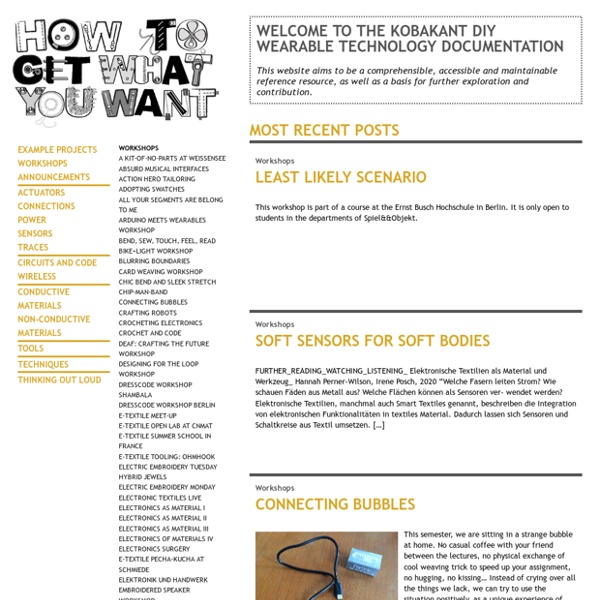FabTextiles
Seamless: Digital Fabrication jacket uses a variety of digital and analog tools. With the use of digital computing and fabrication methods we are able to rapidly prototype and assemble new designs. You can use any 2D or 3D software to create patterns ready for cutting. The machines allow a us a wide range of possibilities, so try to take advantage of the accuracy, precision, and repetitions these machines can achieve. If you don’t have them, these tools can be found at your local Fab Lab, tech shop, or digital fabrication laboratory (if you don’t have them at home, and aside from the laser cutter, you probably will) book a time slot for fabrication with your local fablab or tech shop. Recomended Tools & Materials:
E-Textile Swatch Exchange
YEAR OF INVENTION: 2017CREDITS: BeamDIMENSIONS: 150 x 110 mm With a rectangular piece of carbon non woven, a microcontroller ATtiny85, with two analog inputs and 4 LED’s a device can be made which indicates on which quadrangle of the carbon a droplet of water has been fallen. Over the rectangular piece of carbon non woven a voltage is applied. In a dry state this will cause a linear fall in voltage.
Cheap Alternative for Hard to Find CDS Light Sensor
CdS (Cadmium Sulfide) photo-resistors are commonly used for detecting light levels. Their resistance varies considerably depending on the intensity of light striking them. They are common, fairly cheap and easy to use. So what’s the problem? They are becoming hard to find. The reason is because of the RoHS directive.
ElectroPUFF Craft Kit
Discover the magic of electronics textiles! Make your own ElectroPUFF Lamp Dimmer with this fun, easy and educational craft kit. The ElectroPUFF Lamp Dimmer is a soft, whimsical pompom that controls any incandescent table lamp with just a gentle tap. By combining colorful recycled carpet fibers with special conductive yarns that sense your touch, you'll create a truly unique object that's as much fun to make as it is to use! •Fun & easy for everyone!
Brooke Roberts
Sarah Simpson is a lawyer focused on technology at Taylor Vinters, London. It was while presenting at the inaugural FashTech conference in London that we happened to meet this incredible woman. Having taken a great interest in Brooke's presentation, Sarah met Brooke after the event. Since then she has become our go to person for all things legal within the creative and technology realms. Always professional and open minded, she has become an invaluable member of the team and we were overjoyed when she agreed to not only star in a photo shoot at the Taylor Vinters office at Tower 42, but also agreed to be interviewed for our blog. We met up with Sarah at Tower 42 in London for the shoot and styled Sarah in our Maurits dress.
Small, Programmable, Wearable and Cheap - Enjoying the ATTiny85 - Tutorial by @fctry2
Ok, so let’s talk cheap and tiny: programmable computers needn’t be large precious things, they can be tiny things that we can leave behind, let go, abandon to the cruel world. I’m not advocating being overly irresponsible or wasteful, but I do think that the world and the things that you can make in it gets a lot more interesting if you don’t have to worry inordinately about protecting your project. An Arduino or Raspberry Pi, wonderful tools that they are, are not cheap, somewhat demanding of battery life, and as such we usually need to protect our controller and modify our project to fit their form factors. As a teacher, I can’t count the number of times I’ve seen an Arduino used to listen for a button press or wait for a door to open.
Joy Slippers Version 2
These slippers have 4 analog pressure sensors embedded. They can be used to feed Up, Down, Left and Right values into your computer replacing your mouse, joystick... Visit the JoySlippers website >> This Instructable improves upon the previous version It will show you how to make a pair of Joy Slippers, connect them to an Arduino physical computing platform and run a Processing application that will allow you to draw with your feet, as seen in the following video. The resistance range of the pressure sensors depends a lot on the initial pressure.
What We Do — FashTech
FashTech® aims to drive creative partnerships between fashion and technology start-ups and provide a platform for the latest innovations to be showcased to leading brands and retailers. Since February 2014, we began revolutionizing the fashion technology world; one event at a time. First London, then spreading to San Francisco, and now our latest project - FashTech NYC which launched this September. With over 10,000 members in the FashTech community, with interests spanning from wearable technology, to e-commerce and even 3D body scanning: 2014 was an interesting year for fashion tech with 2015 looking to be bigger and better! We aim to provide a platform for startups and leverage creative partnerships for fashion tech creativity, with our guests at the events ranging from start-ups, investors and of course fashion tech fanatics. No matter how big or small the company, anyone can showcase at the events.
Programming an ATtiny w/ Arduino 1.0
This tutorial shows you how to program an ATtiny45, ATtiny85, ATtiny44 or ATtiny84 microcontroller using the Arduino software. These are small, cheap ($2-3) microcontrollers that are convenient for running simple programs. The ATtiny45 and ATtiny85 have eight legs and are almost identical, except that the ATtiny85 has twice the memory of the ATtiny45 and can therefore hold more complex programs.
Knit a Working Circuit Board
For this instructable, I'll demonstrate how to knit circuitry, using a simple LED circuit as an example. The instructions assume you already know how to knit, solder, and wire up LEDs. (If you need to brush up on those skills, there are great tutorials all over the web.)



